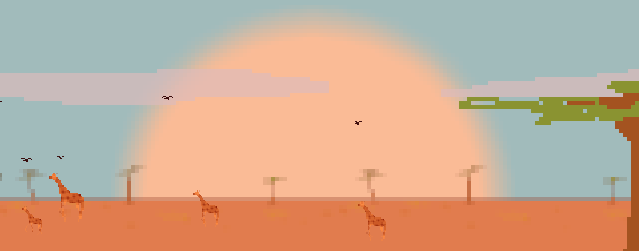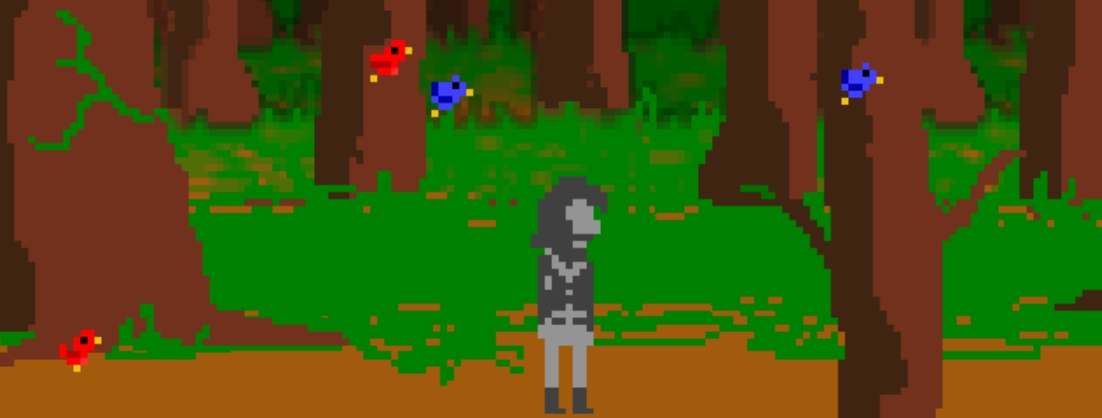Trending
Opinion: How will Project 2025 impact game developers?
The Heritage Foundation's manifesto for the possible next administration could do great harm to many, including large portions of the game development community.

Featured Blog | This community-written post highlights the best of what the game industry has to offer. Read more like it on the Game Developer Blogs or learn how to Submit Your Own Blog Post
When translating a story from any medium into a game, there is a lot to consider: the tone, the themes, the settings. What do you keep? What do you discard? What does that mean for the player? Here, I analyze several examples, including one of my own.

This article was originally written for the Arcade Review in 2015. After talking on the Game Design Adaptation Strategies for Literary and Classical Texts panel at DIGRA/FDG 2016, I updated and altered the piece. It is also part of an on-going series recounting the lessons I’m learning while making 100-games-in-5-years.
For clarity, when referencing any "Harry Potter and the Philosopher’s Stone" media, I will be referring to it as its American released title of "Harry Potter and the Sorcerer’s Stone."

Instructions: Fill in the blank. Below is a written-out walk-through from a syndicated intermedia game. When character names and specific locations are mentioned, you will have the option to choose from three different Intellectual Properties: Harry Potter and the Sorcerer’s Stone, Lord of the Rings: Fellowship of the Ring, and Star Wars: A New Hope.
You emerge from (a lit hallway of Hogwarts/a hobbit hovel/the moisture farm). Others wander about minding their own business, yet all seem repelled by you and dissipate as you enter the scene. (Dumbledore/Gandalf/Obi Wan) approaches, “Welcome to (Hogwarts/the Shire/Tatooine). I am (Albus Dumbledore, your headmaster/Gandalf, your uncle’s friend/Obi Wan, your mentor). Now, (Hogwarts/the Shire/Tatooine) is full of secrets, (Harry/Frodo/Luke), so search everywhere. But keep in mind, not all secrets are rewarding. Now hurry or you’ll be late.”
He stops talking but remains: silent, standing, staring off into space. Now just a piece of scenery no different from the level itself. No matter what you do, he pays no attention. When he was animate, his voice didn’t quite match the actor’s you remember from the film, but it’s close enough to appease your inner fandom.
You continue on the linear path, and another character runs out to meet you in this textured void. “Hey, (Harry/Frodo/Luke)! Remember me, (Ron Weasley/Samwise Gamgee/Uncle Owen). My (brothers Fred and George/friends Merry and Pippin/droids R2-D2 and C-3PO) have something to show you. Follow me!” As he speaks, an aimless character runs past, apparently forgotten by the introductory herd. (Ron Weasley/Samwise Gamgee/Uncle Owen) scurry down the single path game corridor, seemingly unresponsive to your movements. “Follow me (Harry/Frodo/Luke)!”
This NPC pauses in front of a statue, rotates to face you. Next to the statue are (brothers Fred and George/friends Merry and Pippin/droids R2-D2 and C-3PO). “Hello, (Harry/Frodo/Luke). We can show you how to get around (Hogwarts/the Shire/Tatooine). Follow us for a secret lesson.” (Ron Weasley/Samwise Gamgee/Uncle Owen) begin to speak again, “I’ll see you later (in Defense Against the Dark Arts Class/at the festival/back at the moisture farm). Good luck, (Harry/Frodo/Luke)!
A secret passage way opens up and your two new caretakers hurry inside. Your only mode of travel is run, and you easily keep their pace. The next dialogue you hear is “We’re going to teach you how to climb.”

With a bit of paraphrasing (and added character choices), the fill-in-the-blank excerpt was drawn directly from the Harry Potter and the Sorcerer’s Stonegame. It isn’t very much a one-to-one of the novel of the same name as it is a platforming action-adventure with Harry Potter skins and film IP laid over it. This isn’t a bad thing, nor is the game a “bad game.” The 3D version received mixed rating with the highest at 8/10 by GameZone for the PC version and the lowest a 4/10 by GameSpot. What is important to note is that this game is heavily catered towards Harry Potter fans, effectively an appendage of the Harry Potter media empire. Without having read the novel or seen the film, the interactive experience would make little sense.
A few minutes farther into the game beyond the above walkthrough, you’re tranced into another pseudo-cut scene: “It’s me, Hermione Granger. We met on the Hogwarts Express, remember?” If we rely solely on the game to rhetorically answer this question (the game itself never prompts you for an answer), our answer would be “no, we do not remember you.” The game began with us exiting a hallway inside this labyrinth of castle textured passages all of 15 minutes ago.
The goal of this Harry Potter game, as with a lot of syndicated IP, is one of revenue tied into the Harry Potter media franchise: familiar mechanics paired with recognizable characters. The assumption is that the audience is well acquainted with the backstory and plot, so the game cuts straight to the game-y aspects. The game was a success. Harry Potter and the Sorcerer’s Stonegame was profitable enough that, after its 2001 PC and PlayStation release, it was remade and released in 2003 for next-generation consoles.
Yet, when solely viewing the game in relation to the narrative world it is meant to embody, it lacks. Never once while playing this game do you ever truly feel like Harry Potter. The critical aspects of the story are gone, the literary devices are missing, character development and world building are nil. It is a 3D gamified space (collectables and achievements included) with select Harry Potter characters, terms, lore, and settings layered on it.
Regardless of how much Hogwarts paraphernalia populates every corridor, the game keeps reminding you of who you are meant to be, keeps asking if you remember who everyone around you is. “Harry Potter, it’s me, your best friend.” “Harry Potter, it is I, Severus Snape.” “Harry Potter, don’t you remember us? What’s wrong? Please remember us.” As if these reminders will keep us sated, tied into the gameplay just long enough to make it to the next “Hey Harry, I’m Neville Longbottom.”
Faithful intermedia translation games overcome this issue in a completely different way; rather than add the visage of novels and cinema to games, they use mechanics and conventions to reinforce the media’s message. They don’t wear the image of a story, they become inseparable from it, stronger because of it.

Before moving deeper into intermedia translations, I’d like clear up some terms. First, while writing this piece, I’ve only used the term “intermedia translation” instead of “intermedia adaptation.” While I liberally interexchange the two elsewhere, it felt necessary to stick to one here for clarity. Secondly, intermedia translations are stories transposed from one medium into another: novel to film, novel to videogame, videogame to film, etc. This is different than transmedia experiences.
Transmedia experiences have a shared universe across mediums. Think about the Star Wars universe. The films and games cover different ground; Star Wars: Knights of the Old Republic is set way before the Star Wars films, but they coexist in the same timeline. Their content supplement each other, deepening audience’s understanding of the Star Wars world when the audience consumes both.
Harry Potter and the Sorcerer’s Stone game, when compared to the film, tries its best to emulate visual details, voices, surface elements. It doesn’t translate the power, emotion, the feeling of Harry Potter, but it does utilize the IP. It doesn’t expand on the Harry Potter universe but tries to recreate the Sorcerer’s Stone’s plot through familiar faces.
A faithful work of intermedia translation won’t overtly remind you who you are meant to be. It won’t impose mechanics that conflict with its message; and it won’t try to catch you up on plot point from the story, because it is the story, and you participate in the plot by playing.
Another element that syndicated IP games tend to omit is a critical lens. They don’t question reality the way the novels and stories they are based on do. The written Harry Potter makes strong statements. It reflects ideas about the world and provides material for deep discussions and debate. Conversations about games that wave brand banners typically revolve around how fun or not-fun the play is. Faithful intermedia translations can invoke these conversations too, but a lack of fun can be a positive.
As an example of a game that wouldn’t be quite fun, I wouldn’t expect a faithful Call of Cthulhu to be fun. Rather, it would be frighteningly engaging, almost intoxicating. The player should grow obsessed with completing the game, unraveling the plot and mystery just as the character’s madness deepens in his own search.
So if we’re not making a game with the goal of fun or a game that uses game-y mechanics, how do we make intermedia translations games? What do we keep when converting stories from one medium to another?

Intermedia translation videogames are games that, ideally, keep the theme, mood, and tone intact of an original work, while converting it into a videogame. The end result should be a game that contains similar depth and critical theory to that of the written work. If you’re playing a faithful intermedia translation game, you should be able to have a critical discussion about the theme, message, and overall plot with someone who has only read the written fiction. To take this idea a step further, if you were to write a story recounting the game, it should be similar to that of the original work. Just imagine what a book translation of Harry Potter and the Sorcerer’s Stonegame would be like. For starters, every chapter would have Harry collecting floating jelly beans and eating chocolate frogs to restore health.
I Have No Mouth and I Must Scream might be the most renowned intermedia translation game, winning several awards when it was released in 1996 along with critical acclaim. Based on the short fiction of the same name, what makes I Have No Mouth and I Must Scream an interesting example of an intermedia translation is that the game has significantly more content than the story. Yet it wasn’t distant developers that created the growing storyline and expanded the characters. Harlan Ellison, the author of the original story, was on the design team and created the expanded world in collaboration with David Sears. This allowed the gameplay and story to co-exist. So if this game has expanded content, how is it an intermedia translation?
It’s a misconception to think that an intermedia translation game would mirror the exact story. What works in a novel won’t work in a film won’t work in a game. You have to incorporate the new medium into the story using its benefits to strengthen the story, and work around the downsides. In the case of I Have No Mouth and I Must Scream, Harlan Ellison and the design team used interactivity to strengthen the story. What if the written story is one possible outcome from a slew of possible endings? The original written fiction ends horrifically, and out of four endings the player can unlock in the game, three of them are horrific. There is only one ending with any hope to it.
The majority of player choice in the game lies between losing-and-suffering-with-dignity, or losing-and-suffering-with-selfish-intent. All of this reinforces the desperate hopelessness of the short fiction. Unlike the Harry Potter game, it would be hard to reskin the I Have No Mouth and I Must Scream game with other familiar IP. The mechanics, for the most part, are inseparable from the game’s message. This conjoining of play and message is at the heart of intermedia translation games. And as I Have No Mouth and I must Scream shows, it doesn’t have to always be happy.
The gift of videogames is that they are separate from reality. Not solely to let us escape, but for us to safely explore, firsthand, emotions and experiences that novels can only describe to us and films can only show us.

Condensing what we now have about intermedia translation games into a paragraph: intermedia translation games are games that, ideally, keep the theme, mood, and tone intact of a written work (or other medium), while translating it into a videogame. They don’t have to be fun; not all fiction is fun. The end result should be games that contain similar depth and critical theory to that of the written works they’re based on. You should be able to hold a critical discussion about the message of the story with someone who has only read the written fiction. The game shouldn’t force escapism on the player. And finally, every aspect of the game should support the story.
Some of these feel like common sense. Others I’ve come to learn through the intermedia translations I’ve made, including An Occurrence at Owl Creek Bridge and The World the Children Made, awarded Silver at Serious Play Conference 2013 and 2014 respectively. It’s important to draw comparisons between literature and game design to successfully convert a story between mediums, even more so to analyze and understand them. Every mechanic and aspect of the game will affect the way the player interprets and feels through the system, much like how every word and sentence affects the story.
An Occurrence at Owl Creek Bridge is the first intermedia translation game I made. Based on the short fiction of the same name, the story opens with a man at the edge of a bridge with a noose around his neck, Union soldiers of the American Civil War behind him. The written work provides us a glimpse into his backstory: how he was a confederate sympathizer but remained on his farm instead of joining the battle, how one night he got a tip in a bar about how he could sabotage a union bridge, a plan that went very wrong. I omitted this backstory within the game in favor of simplicity and to create a more cohesive experience. My game An Occurrence at Owl Creek Bridge, besides the opening title and credits, has no written or spoken dialogue.
This choice was made to highlight and use the benefits of telling a story through an interactive visual system over written word. Because of the affordances of videogames, I wanted to avoid written language as much as possible. My translation also has minimal pixelated graphics. Although pixel art is perpetually in style limbo, I chose this art direction to help support player’s curiosity and interpretation; to create an atmosphere similar to that of the written fiction.
Because of the low fidelity of the characters, faces only 5 pixels tall, we make out our own personalized details: eyes, mouths, ears, personalities. Much as how we interpret descriptions in written fiction: what does a "mouth" look like? What does it mean when it reads "firey eyes?", we use our imaginations to humanize the minimal digital renderings in the game. Further, by having our protagonist in gray at the edge of the bridge and the soldiers behind him in blue, we can begin inferring meaning: we know he is not one of them due to the uniform color difference. If we’re familiar with US history, we know that gray is the associated color of the Confederate Army while Blue is the Union (a facet that, if not recognized, will not hamper the experience). It sets an analytical mindset and primes the player to interpret the game.
Ultimately, these elements are only a few that went into crafting this intermedia translation game. Components that players may not consider while experiencing the game, yet components that shape their journey and understanding of the piece nonetheless; precision crafting elements to ensure it communicates the story as well as it can.

What does this all mean in the end? Some people may not enjoy intermedia translation games. That’s perfectly fine! Some people just don’t enjoy short form fiction much like how some people don’t enjoy videogames. People’s tastes are people’s tastes, but we should know what we consume and the meaning behind it.
My brother Joe has a phrase for syndicated videogames. It’s a term he applies to Michael Bay films as well: cultural filler; a term that’s grown on me. It’s not a condemning term. Simply put, it’s a term that can be used to describe media that doesn’t add significant artistic value to its field; media that doesn’t want to be new or stand out from the crowd. Almost kitsch but without as much homeliness. And that’s ok. Knowing that a bag of chips isn’t nutritious doesn’t make it less tasty.
Intermedia translations take time to parse. They use energy to unravel and figure out. They may not be fun to play. You have to grapple with them: what is the message? Do I agree with the message? Does my world view fit my agreeing with the message? Do I have to change my world view now? What does that say about me?
It can be exhausting to play and make them, just like reading the fiction they’re translated from. They can be powerful, just like reading the fiction they’re translated from. They can be moving, stimulating, tear-jerking, hopeful, hopeless, and heart-wrenching, just like the fiction they’re translated from. But some days I come home and I’m not looking for deep content. Sometime I just want to blend in and be a mild body.
We all have days like these, when we get tired of trying to stand out. We throw on a hoodie and sweats, crash on the couch, soak in some cultural filler. Perhaps dust off the old PS1 and boot up the last game we left in the system. “Hello Harry, remember me? I’m Ginny.”
Read more about:
Featured BlogsYou May Also Like